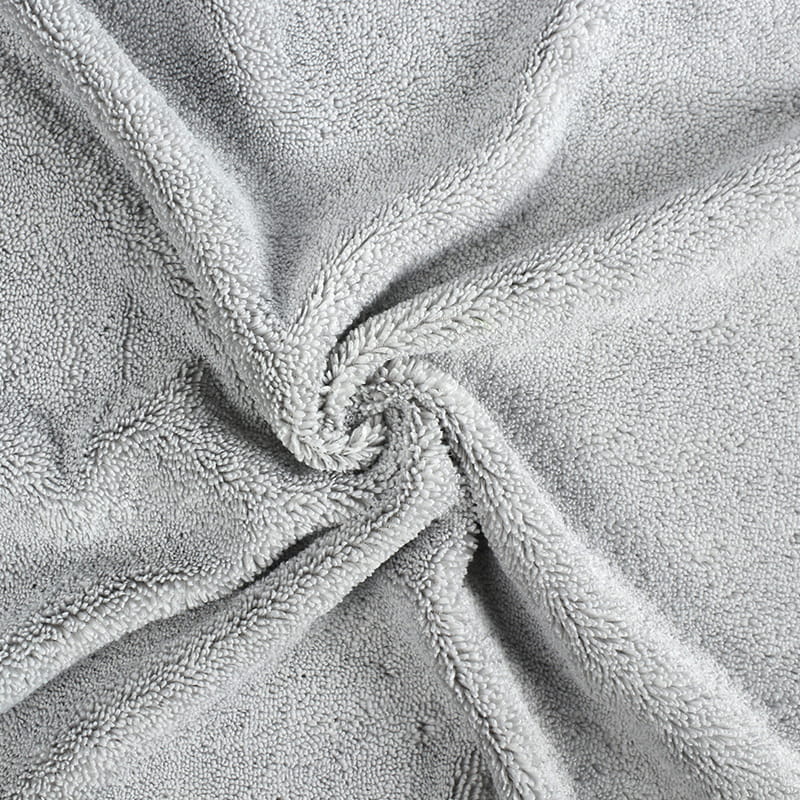We are a national high-tech enterprise. At present, there are many kinds of self-woven and cooperatively processed fabrics, including microfiber warp-knitted towel cloth, weft-knitted towel cloth, coral fleece, etc.
There are innovative technologies and materials used in kitchen cleaning towels to enhance their cleaning performance. Some of these include:
Microfiber Technology:
Composition Details: Microfiber towels are meticulously crafted with synthetic fibers, typically a blend of polyester and polyamide. These fibers undergo advanced processing to achieve an ultra-fine structure, enhancing their cleaning capabilities.
Fiber Structure Dynamics: The microscopic size of microfiber allows for a dense weave with intricate interlocking fibers. This structure creates a vast surface area, ensuring superior absorbency and trapping of particles.
Precision in Cleaning: Microfiber's ability to capture particles as small as a fraction of a micrometer sets it apart. This precision in cleaning makes it highly effective in lifting and holding dirt, grime, and even microscopic contaminants, providing a thorough cleaning experience.
Antibacterial and Antimicrobial Treatments:
Scientific Integration: Kitchen cleaning towels with antibacterial or antimicrobial treatments involve a scientific integration of agents like silver ions or other antimicrobial substances. This process occurs at the molecular level during manufacturing.
Continuous Protection: The integrated agents create a continuous protective layer on the towel's surface. This not only actively inhibits the growth of bacteria but also prevents the development of odors, ensuring a consistently fresh and hygienic cleaning tool.
Nano-Fiber Technology:
Nanotechnology Precision: Nano-fiber technology operates at the nanoscale, with fibers measuring in the nanometer range. This level of precision allows for an exceptionally fine and densely packed structure, surpassing traditional microfiber technology.
Molecular-Level Cleaning: Nano-fiber towels excel in capturing particles at a molecular level. Their advanced structure enables them to reach into the smallest crevices, making them ideal for tasks demanding the highest level of cleanliness and precision.
Dual-Sided Design:
Material Engineering: Kitchen cleaning towels with a dual-sided design are engineered with distinct materials on each side. One side may feature a soft, smooth texture for gentle wiping, while the other may incorporate a more abrasive surface for effective scrubbing.
Task-Specific Efficiency: Users can tailor their cleaning approach by selecting the side that aligns with the specific cleaning task. This customization enhances overall efficiency, making these towels versatile and adaptable to a variety of kitchen cleaning needs.
Quick-Drying Materials:
Moisture Evaporation Dynamics: Quick-drying kitchen towels are crafted from materials that optimize moisture evaporation. This ensures rapid drying after use, reducing the likelihood of bacterial growth and maintaining a consistently dry and hygienic towel.
Resilience in High-Usage Scenarios: In environments with frequent towel usage, quick-drying materials exhibit resilience by efficiently managing moisture. This feature is especially beneficial in professional kitchens where maintaining a high level of cleanliness is paramount.
Eco-Friendly Materials:
Sustainable Sourcing Practices: Towels made from eco-friendly materials, such as bamboo or organic cotton, adhere to sustainable sourcing practices. These materials are derived from renewable resources, promoting environmental responsibility in the production process.
Reducing Environmental Footprint: The use of eco-friendly materials minimizes the environmental impact associated with traditional manufacturing processes. This aligns with the broader goal of reducing the overall environmental footprint of kitchen cleaning towels.
Color-Coded Systems:
Strategic Organizational Approach: Color-coded systems are not merely a visual distinction but a strategic organizational approach. Different colors are assigned based on specific criteria such as tasks, areas, or types of cleaning agents, creating a systematic and efficient cleaning process.
Hygiene Optimization: In commercial kitchens, the meticulous implementation of color-coded systems optimizes hygiene. The systematic approach minimizes the risk of cross-contamination, ensuring that towels designated for different purposes are easily identifiable, thereby maintaining a pristine and hygienic kitchen environment.
1PK high and low hair pet towel

1PK high and low hair pet towel


 English
English Espaol
Espaol русский
русский عربي
عربي 简体中文
简体中文
















